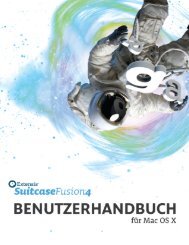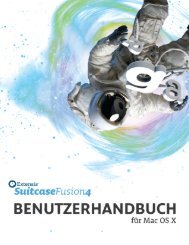Suitcase Fusion 3 User Guide for Mac OS - Extensis
Suitcase Fusion 3 User Guide for Mac OS - Extensis
Suitcase Fusion 3 User Guide for Mac OS - Extensis
You also want an ePaper? Increase the reach of your titles
YUMPU automatically turns print PDFs into web optimized ePapers that Google loves.
Enabling a Type Drawer<br />
When you enable a Type Drawer:<br />
• The WebINK fonts you’ve added to it will be served to your websites.<br />
• Billing <strong>for</strong> the Type Drawer starts.<br />
To enable a Type Drawer:<br />
1. Select the Type Drawer.<br />
2. Click the Type Drawer In<strong>for</strong>mation button at the bottom left of the <strong>Suitcase</strong> <strong>Fusion</strong> window to show the<br />
Type Drawer in<strong>for</strong>mation.<br />
3. Check the box labeled Enabled.<br />
To disable a Type Drawer, uncheck the Enabled box <strong>for</strong> that drawer.<br />
About Disabled Type Drawers<br />
When you create a Type Drawer it is in a disabled state, so that you can add fonts and websites at your leisure<br />
without incurring a charge. When you first enable a Type Drawer, you will be charged <strong>for</strong> usage through the end<br />
of the current calendar month, then charged at the beginning of each subsequent month.<br />
When you disable a Type Drawer, WebINK will immediately stop serving fonts to the sites associated with that<br />
drawer, even though you have already paid <strong>for</strong> the service through the end of the month. Any published CSS<br />
that refers to the disabled Type Drawer will use fallback fonts instead of the WebINK fonts.<br />
Keep this in mind when you create Type Drawers. To avoid unnecessary billing, a good plan is to leave the Type<br />
Drawer in the disabled state, add fonts and websites to it, generate the CSS, and add the CSS to the<br />
appropriate style sheets. When you have done all this, enable the Type Drawer and enjoy your customized<br />
websites!<br />
Managing websites<br />
A website can be:<br />
• A complete hostname, such as www.example.com.<br />
• The word localhost, <strong>for</strong> testing on a web server on your local workstation.<br />
• An IP address, such as 12.34.56.78 (especially useful <strong>for</strong> websites on your local network).<br />
• A hostname with wildcards replacing the subdomain, the top-level domain, or both.<br />
A website string with wildcards is a powerful way to easily include all possible sites <strong>for</strong> a client. For example, by<br />
using *.example.com, your Type Drawer will serve fonts to www.example.com, blog.example.com,<br />
jobs.example.com, and any other subdomain of example.com.<br />
You can also include multiple top-level domains by using the wildcard in the final position of the website name.<br />
For example, using example.co.* allows a single Type Drawer to serve fonts to example.co.uk, example.co.jp,<br />
example.co.de, and all other “dot-co” websites.<br />
Website strings cannot include wildcards to replace part of a string, like www.ex*le.com, and cannot be used to<br />
cover all domains, like www.*.com. The wildcard can only be used to specify the subdomain, the top-level<br />
domain, or both.<br />
Cautions<br />
• Be careful deploying CSS to a live website when localhost is assigned to the same Type Drawer.<br />
localhost is useful <strong>for</strong> local testing, but if published CSS includes a Type Drawer with localhost, it could<br />
lead to unexpected overages in your bandwidth.<br />
• Don’t include wildcards <strong>for</strong> hosts that might be outside your control (such as *.blogger.com or<br />
*.intuitwebsites.com). Anyone with a subdomain on these hosts could conceivably copy your CSS and<br />
use your WebINK fonts, causing you to be billed <strong>for</strong> the higher bandwidth usage.<br />
- 87 -









